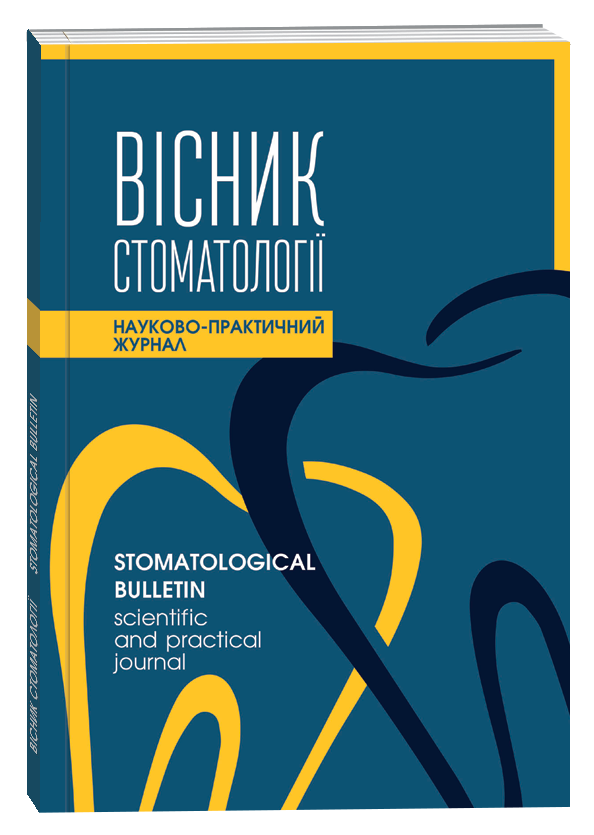IMMUNOLOGICAL STATUS OF PATIENTS WITH PHLEGMON OF THE MAXILLOFACIAL AREA
DOI:
https://doi.org/10.35220/2078-8916-2023-50-4.8Keywords:
phlegmon, maxillofacial area, immune status.Abstract
Purpose of the study. To increase the effectiveness of treatment of patients with phlegmons of the maxillofacial area thanks to the assessment of the immune status with the determination of the most informative indicators and the number of subpopulations of immunograms among Tand B-lymphocytes. Research methods. 120 people aged 20-80 with maxillofacial phlegmons were treated in the maxillofacial department of the city hospital of emergency and urgent medical care in Zaporizhzhia. In 1 group (60 people), the treatment was carried out according to the traditional method. In group 2 (60 people), traditional treatment was supplemented (active drainage of purulent postoperative wounds with constant reduced negative pressure at the stage of exudation, administration of a second antibacterial agent via the lymphatic route according to indications, administration of PRP at the stage of reparation). Immune status was assessed by determining a set of laboratory indicators characterizing the quantitative and functional activity of cells of the immune system by immunofluorescence using sets of labeled monoclonal antibodies to surface lymphocyte antigens CD3+, CD20+. To determine the characteristics of the severity of the immune response, the concentrations of immunoglobulins A, M, and G were determined in patients of both groups. Scientific novelty. The study was conducted on the 1st day of the postoperative period, repeated on the 5th day after the operation to assess the immune response to the treatment. Conclusions. A decrease in the ratio of CD4+ / CD8+ lymphocytes can be explained by the presence of inflammatory processes. According to the indicators of humoral immunity, in patients with CKD, in comparison with the control group, a decrease in the content of IgG and IgM in the blood serum was noted at the second stage of blood sampling in the two groups (p ≤ 0.05, since at the first they were within the upper limit of the norm in comparison with healthy individuals and p = 0.019, respectively). An increase in the content of CIC (medium and small units (p ≤ 0.05)), which is probably a reflection of a decrease in the immune response in these patients or a consequence of constant persistence of the pathogen.
References
Аветіков Д.С. Личман В.О., Локес К.П., Стебловський Д.В., Бондаренко В.В., Шликова О.А. Лікування одонтогенних флегмон у хворих з урахуванням біоритму життя. 2021. № 74(6). С. 1346-8.
Климнюк С.І. Практична мікробіологія: навч.посіб. Вінниця. Нова Книга. 2018. С. 576.
Широбоков В.П. Мікробіологія, вірусологія та імунологія в запитаннях і відповідях: навч. посіб. Тернопіль. ТДМУ. 2019. С. 564.
Казмірчук В. Є. Інтерпретація лейкограми та імунограми згідно з сучасними позиціями. Внутрішня медицина. 2007. № 4(4). С. 36-44.
Мацко Н. В. Зміни імунологічного статусу в пацієнтів із патологією тканин пародонта у поєднанні з виразковою хворобою шлунка і дванадцятипалої кишки. Вісник наукових досліджень. 2014. № 1. С. 19-20.
Личман В.О., Локес К.П., Аветіков Д.С., Горлач Н.В., Гончаренко О.О., Шарай ЮР. Вплив кріоконсервованої плаценти на динаміку клінічних показників при лікуванні пацієнтів із флегмонами щелепно-лицевої локалізації з урахуванням циркадного ритму. Український стоматологічний альманах. 2021. № 4. С. 11–14.
Furuholm J, Rautaporras N, Uittamo J, Saloniemi M, Snäll J. Health status in patients hospitalised for severe odontogenic infections. Acta Odontol Scand. 2021 Aug. 79(6). Р. 436-442. doi: 10.1080/00016357.2021.1876916
Nicot R, Barry F, Raoul G, Wiel E, Delfosse C, Ferri J. The inception of a hospital-based dental emergency department in a precarious region decreases the incidence of severe cellulitis of odontogenic origin. J Stomatol Oral Maxillofac Surg. 2022. Nov. 123(6). Р738-742. doi: 10.1016/j.jormas.2022.05.018
Uittamo J, Löfgren M, Hirvikangas R, Furuholm J, Snäll J. Severe odontogenic infections: focus on more effective early treatment. Br J Oral Maxillofac Surg. 2020. Jul. 58(6). Р. 675-680. doi: 10.1016/j.bjoms.2020.04.004.









